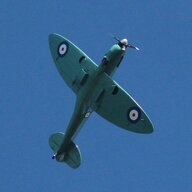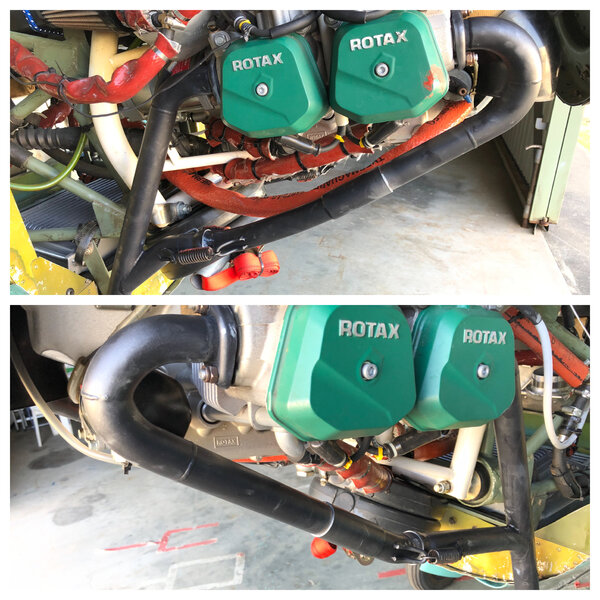-
Posts
29 -
Joined
-
Last visited
Content Type
Profiles
Forums
Gallery
Downloads
Blogs
Events
Store
Aircraft
Resources
Tutorials
Articles
Classifieds
Movies
Books
Community Map
Quizzes
Everything posted by K5054
-
The fuel pressure is at the higher end when return line is closed but gets close to limit when boost pump is on. With return line open it sits about 3-4 and 5-6 with boost pump on
-
The engine is 2018 so the pump is new and correct. The fuel pressure gauge is and old one direct reading though. Can’t really tell how accurate it is. It takes its pressure from Y fitting just before the 1/3 carb
-
I tried a number of different size restrictors in return line starting with the recommended size but that back pressure pushed the fuel pressure too high, so I started increasing size incrementally until it was within limits. This ended up being quite a large bypass hole. Recommended factory return line restriction is 0.35mm mine is 1.5mm in order to keep fuel pressure in limits which is over four times the normal. On the up side, there is less chance of getting a blockage 🤔
-
Actually I had a read again and I think you are right. I have to add another pin to the gauge plug. I was wondering if I just pigtail the power from the existing wires and you think I do 👍 I also am guessing that leaving it as single engine makes it subtract 👍 it means I can save a lot as a second cube is only about $250 I will try it out. I’ll let everyone know how it goes. thanks for the help 👍👍
-
Mine is very accurate if I close return line off. It’s the fuel flow when return is open that it cant cope with. I would get a second transducer if I knew how to wire it into my gauge as it says you can (pin 8 but it’s not clear how to. it would be a lot cheaper to just get another transducer
-
The k factor can’t go low enough to cater for the return.
-
I think I will sell it and install this https://www.scintex.com.au/products/engine-fuel-consumption-gauge-supply-return?_pos=30&_sid=a33b01d08&_ss=r
-
I did try a few locations in the engine bay but now it is on the floor below the tank in cool non vibration area with straight hose before and after on cabin side of firewall. It’s a 912ULS. I could try a different return orifice which would bring fuel pressure higher but still in limits. If I adjust k factor for cruise rpm, wouldn’t that change with altitude as power drops off making the readings only accurate for where I set it at low altitude?
-
Thanks I appreciate your response. I’ve tried that technique before though over a year or two. I tried various k factors to accommodate the return line but the fuel flow varied too much throughout the rev range. At the moment my fuel flow is say 20lph but total with return line is 53lph. This is with the return line orifice that gives the correct fuel pressure. I have also tried putting the transducer on one carb and doubling amount. Again, not accurate. I’m not sure what else to try. At the moment I can get accurate reading by manually shutting return off in flight.
-
Does anyone have a diagram on how to wire a second “red cube” onto the FC-10 meter for the return line on a rotax. The instructions are too vague
-
Hi, can anyone tell me if I am allowed to hire out my aircraft to someone for private hire as in they can use my aircraft but pay me an hourly rate for its use? (VH rego)
-

Anyone seen a Wingbug in the wild?
K5054 replied to Rodj's topic in Instruments, Radios and Electronics
The wing bug software only allows setting altimeter in inches. I have written to them and he said he should be able to put hectopscals in and will let me know. You should send a similar email as they are cutting themselves out of the austrAlain market and the more enquiring about it, the quicker they will fix it. I have a similar problem. Can’t put mounted instruments in without big expense (VH rego) and really old instrumentation. So I’m currently looking at the wing bug. BOM is the alternative. I think they are both great product. Wingbug a bit cheaper and doesn’t self charge but I would take it home to charge anyway. 10 hours battery is pretty good. but they seem to do the same things. Both have A of A by the way. I do like the wingbug six pack presentation and as I have a portable ADSB in device, I don’t require it. -

Buying aircraft- 80 % / 100 % use case ?
K5054 replied to RFguy's topic in AUS/NZ General Discussion
I have single seat which I love as I enjoy the solitude of flying. It is rare I need to take a pax but I have a share in a two seater I can use if needed. -
Mine in my savannah used to do the same on a hot day. If CHT/water temps are ok (as well as oil temps) it should be fine. Detonation is the main concern but it is to a lesser extent on water cooled heads. Use as high an octane as you can (98) to help against detonation and monitor engine temps.
-
Thanks. Yes I’m 19 rego owner/builder.
-
Howdy, Can anyone Help me with this question? my VHF is in shop being repaired. I have an Icom portable that works well connected to my headsets and transmitting through the Aircraft external Antenna. Battery lasts over Six hours. is it permissible for me to use this set up in the interim while my built in is repaired? I can’t find any Raaus reference. Aircraft is Raaus rego. yes I will be flying in class D airspace.
-

question Question regarding Ceramic Coating on Exhaust/Muffler
K5054 replied to ozzietriker's topic in Engines and Props
I had my exhausts coated in the highest heat resistance. I did it to keep heat down under cowl. It didn’t make a scrap of difference and I have had to wrap them again. If you are going for looks it’s good and will preserve the pipes but don’t bother if you are primarily going for heat reduction -
How do you account for the returned fuel which would be included in the fuel flow?
-
I’m relocating a fuel flow (red cube) sender in my rotax. I think the current set up is too close to the fuel pump on rotax 912ULS and pulses are giving erroneous readings. So I’m lengthening the fuel hose so it has 6 inches of straight hose before and after it (as recommended) My return line has to be upstream of transducer (so I don’t have to buy two) but I’m wondering how far upstream is allowable. Not sure if by having a long length of hose between the return tee and the transducer would defeat the purpose of the return line and allow vapour lock as there would be a fair distance of hose to be heated. (maybe 1200mm) It will all be fire sleeved
-
Hello all, I have recently changed my oil cooler in new (150hours) rotax 912ULS as the temps were slightly high. Oil temps are now good but the CHT’s are higher than before (expected) due to positioning. my engine has the newer CHT limit of 120° my question is are these temps ok. Or should I be concerned and try to lower them? (°C) OAT CHT. OIL 17° 94° 88° (Cruise) 22° 100° 90° (high speed cruise) 20° 110° 105° (extended climb) my CHT temps used to be 70-90°
-
Need more details. landing on grass? carrying too much speed on touchdown? where was touchdown? did they fade or fail? how long is runway? what is pilot skill level? is there grass on side of flightstip? Landing weight? headwind/tailwind. braked and non braked performance? etc etc with all the variables you have to make the call at the time.
-
Empty is about 420kg. Will be something like that. I haven’t got all the details yet
-
Yes it might lose 6 kts at 600kg. Not sure how to drop that much weight though, unless it’s simply restricted to that.



